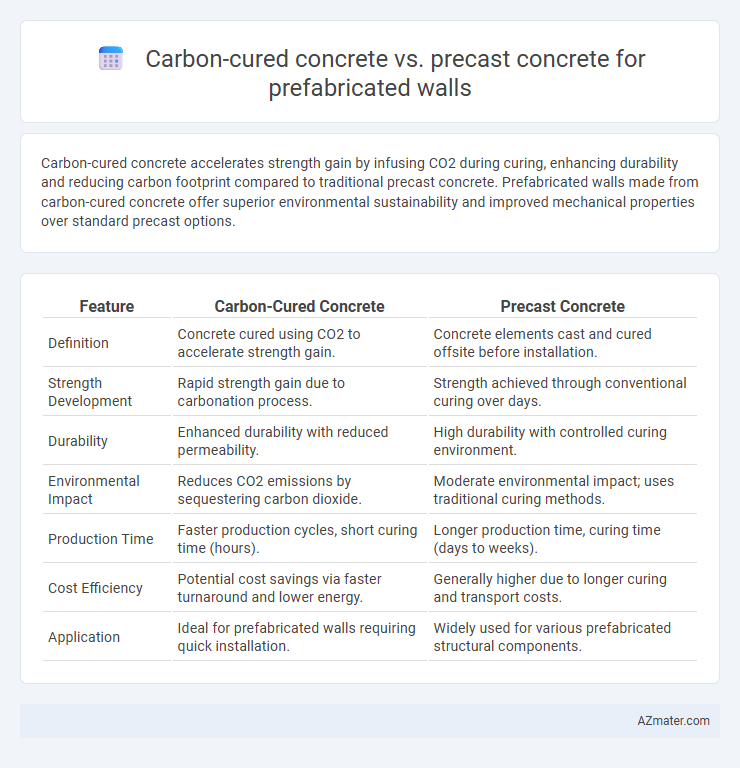Carbon-cured concrete accelerates strength gain by infusing CO2 during curing, enhancing durability and reducing carbon footprint compared to traditional precast concrete. Prefabricated walls made from carbon-cured concrete offer superior environmental sustainability and improved mechanical properties over standard precast options.
Table of Comparison
| Feature | Carbon-Cured Concrete | Precast Concrete |
|---|---|---|
| Definition | Concrete cured using CO2 to accelerate strength gain. | Concrete elements cast and cured offsite before installation. |
| Strength Development | Rapid strength gain due to carbonation process. | Strength achieved through conventional curing over days. |
| Durability | Enhanced durability with reduced permeability. | High durability with controlled curing environment. |
| Environmental Impact | Reduces CO2 emissions by sequestering carbon dioxide. | Moderate environmental impact; uses traditional curing methods. |
| Production Time | Faster production cycles, short curing time (hours). | Longer production time, curing time (days to weeks). |
| Cost Efficiency | Potential cost savings via faster turnaround and lower energy. | Generally higher due to longer curing and transport costs. |
| Application | Ideal for prefabricated walls requiring quick installation. | Widely used for various prefabricated structural components. |
Introduction to Prefabricated Wall Systems
Prefabricated wall systems enable rapid construction by manufacturing components like carbon-cured concrete and precast concrete off-site for quality control and efficiency. Carbon-cured concrete offers enhanced durability and lower carbon dioxide emissions through accelerated curing processes, while precast concrete provides versatility with customizable shapes and structural integrity. Both materials support sustainable building practices, but carbon-cured concrete emphasizes environmental impact reduction in prefabricated wall production.
Understanding Carbon-Cured Concrete
Carbon-cured concrete enhances strength and durability by exposing precast elements to controlled CO2 environments, accelerating the curing process and reducing carbon emissions compared to traditional methods. This technology improves prefabricated wall performance with increased resistance to cracking and reduced permeability, offering a sustainable alternative to conventional precast concrete. Industrial adoption of carbon curing contributes significantly to lowering the carbon footprint of prefabricated construction while maintaining structural integrity.
Overview of Precast Concrete Technology
Precast concrete technology involves casting concrete elements in a controlled factory environment, ensuring high quality and uniformity for prefabricated walls. This method allows for precise dimensional control, faster construction timelines, and reduced on-site labor compared to carbon-cured concrete, which relies on accelerated curing techniques utilizing carbon dioxide injection. Precast concrete offers enhanced durability, improved surface finish, and better integration of reinforcement, making it a preferred choice for large-scale modular wall systems.
Material Composition and Properties
Carbon-cured concrete incorporates high CO2 content during the curing process, enhancing strength and reducing carbon footprint, with a mixture typically consisting of Portland cement, aggregates, and CO2-reactive compounds. Precast concrete for prefabricated walls is composed of cement, water, aggregates, and admixtures, designed for uniformity and high compressive strength achieved through controlled factory curing. The key difference lies in carbon-cured concrete's accelerated strength gain and environmental benefits versus precast concrete's focus on consistency and durability in standardized production.
Manufacturing Process Comparison
Carbon-cured concrete for prefabricated walls involves curing concrete elements in a CO2-rich environment, accelerating carbonation to enhance strength and reduce curing time. Precast concrete manufacturing includes casting concrete in reusable molds under controlled factory conditions, often requiring longer curing periods without CO2 exposure. The carbon-curing process optimizes efficiency by integrating rapid CO2 curing, while precast methods depend on traditional hydration curing, impacting overall production speed and sustainability.
Structural Performance and Durability
Carbon-cured concrete for prefabricated walls exhibits enhanced structural performance through increased compressive strength and reduced permeability, resulting in improved durability against environmental stressors. Precast concrete, while offering versatility and dimensional accuracy, may require additional treatments to match the superior durability provided by carbon curing techniques. The carbon curing process accelerates carbonation, leading to denser microstructures that enhance resistance to chloride ingress and freeze-thaw cycles, extending the lifespan of prefabricated wall elements.
Sustainability and Environmental Impact
Carbon-cured concrete significantly reduces carbon dioxide emissions by capturing and storing CO2 during the curing process, making it a sustainable choice for prefabricated walls. Precast concrete offers environmental benefits through reduced waste and energy efficiency in factory-controlled production but typically relies on traditional curing methods that emit higher greenhouse gases. Choosing carbon-cured concrete for prefabricated walls enhances sustainability by lowering the carbon footprint while maintaining durability and structural integrity.
Cost Analysis and Economic Benefits
Carbon-cured concrete offers significant cost savings in prefabricated wall production due to faster curing times, reducing labor and formwork expenses compared to traditional precast concrete. The economic benefits of carbon curing also include lower energy consumption and potential carbon credit incentives, enhancing overall project sustainability and profitability. In contrast, precast concrete requires longer curing periods and higher on-site handling costs, impacting the total investment and time-to-market for construction projects.
Installation Efficiency and Construction Speed
Carbon-cured concrete offers rapid strength gain by accelerating the carbonation process, allowing prefabricated wall panels to be handled and installed within days, significantly improving construction speed. Precast concrete benefits from controlled factory conditions that ensure consistent quality and dimensional accuracy, reducing on-site adjustments and streamlining installation efficiency. Compared to traditional precast methods, carbon-cured concrete panels demonstrate faster turnaround and early load-bearing capacity, making them ideal for projects prioritizing quick assembly and reduced labor time.
Future Trends in Prefabricated Wall Solutions
Carbon-cured concrete offers enhanced durability and reduced carbon footprint, positioning it as a leading choice for sustainable prefabricated wall solutions. Precast concrete remains favored for its high-strength, rapid installation, and versatility in modular construction, but innovations integrating carbon capture technologies are redefining its future. Emerging trends emphasize hybrid systems combining carbon curing with precast methods to optimize environmental impact and structural performance in next-generation building envelopes.

Infographic: Carbon-cured concrete vs Precast concrete for Prefabricated wall
 azmater.com
azmater.com